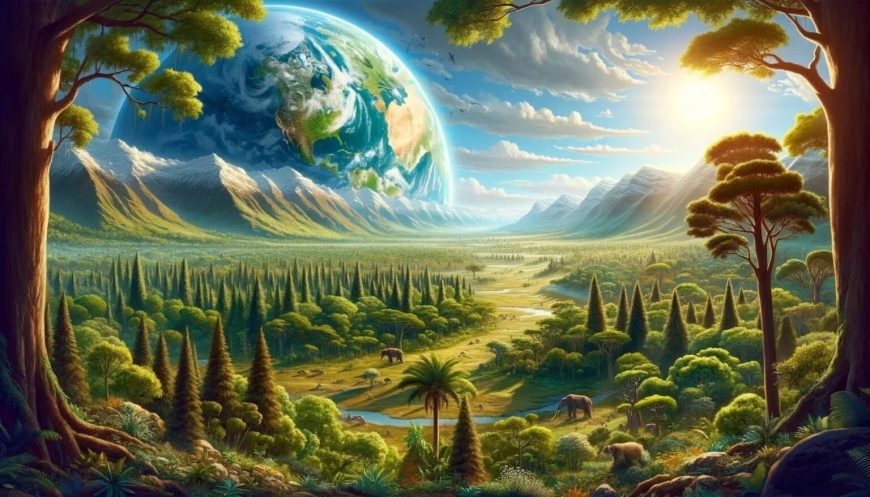How Hot Was the Earth Before the Ice Age?

As we delve into the mysteries of our planet’s past, one question that fascinates scientists and history enthusiasts alike is, “How hot was the Earth before the Ice Age?” This query not only unveils the climatic conditions of a bygone era but also helps us understand the intricate dance between the Earth’s climate and its geological and biological transformations. The period before the last Ice Age, known as the Pleistocene epoch, was a time of significant climatic fluctuations, which played a crucial role in shaping the world as we know it today.
The Climatic Context of the Pre-Ice Age Earth
The Earth’s climate before the Ice Age was markedly different from what we experience in the current Holocene epoch. During the Pleistocene, which began around 2.6 million years ago and lasted until about 11,700 years ago, the planet underwent numerous glaciations and interglacial periods. These cycles were characterized by the advance and retreat of ice sheets over vast portions of the Northern Hemisphere. But what was the climate like during the interglacials, when the ice had retreated?
Research indicates that during these warmer periods, the global temperature was potentially 1 to 3 degrees Celsius higher than the pre-industrial average. This increase in temperature led to several noteworthy changes:
- Rise in Sea Levels: The melting of massive ice sheets contributed to a significant rise in sea levels, in some cases up to 20 meters higher than present levels.
- Expansion of Flora and Fauna: Warmer climates allowed for a northward expansion of plant and animal life, leading to rich biodiversity in areas that were previously ice-covered.
- Changes in Atmospheric Composition: Higher temperatures influenced the levels of greenhouse gases in the atmosphere, creating feedback loops that further impacted the climate.
This ebb and flow of glacial and interglacial periods underscored the dynamic nature of the Earth’s climate system, a balance of forces that continues to affect our planet.
Comparing Pre-Ice Age and Modern Climates
Understanding the temperature before the Ice Age helps us contextualize our current climatic challenges. The Pleistocene epoch was marked by a natural, albeit dramatic, climatic variability. However, the present-day changes are more rapid and largely driven by human activities. Here are some comparisons:
- Natural vs. Anthropogenic Causes: The temperature variations during the Pleistocene were primarily driven by natural factors such as orbital changes, volcanic activity, and solar radiation. Today, human-induced factors like fossil fuel combustion and deforestation play a significant role.
- Rate of Change: The rate of climate change in the lead-up to the Ice Age was gradual, occurring over thousands of years. In contrast, the current warming trend is occurring at a much faster rate, over decades rather than millennia.
- Global Impact: The changes before the Ice Age were primarily characterized by regional shifts in climate and ecosystems. The modern climate crisis, however, has a global footprint, affecting ecosystems, sea levels, and weather patterns worldwide.
The contrast between these two periods underscores the uniqueness and urgency of our current climate situation.
The Impact of Pre-Ice Age Climate on Human Evolution
The climatic conditions before the Ice Age had a profound impact on human evolution. This period saw significant developments in human physiology, behavior, and dispersion. Let’s delve into some of these aspects:
- Human Adaptation: Fluctuating climates necessitate human adaptation. Changes in temperature and environment influenced dietary habits, shelter needs, and mobility patterns.
- Technological Advancements: As humans adapted to diverse climates, there was a surge in technological innovations like tool-making, which were pivotal for survival and progress.
- Migration Patterns: The climatic shifts influenced human migration, leading to the spread of Homo species across various continents and the eventual dominance of Homo sapiens.
This intricate interplay between climate and human evolution highlights how environmental conditions have been a driving force in the shaping of human history.
Lessons from the Past: Understanding Our Climate Future
The study of Earth’s climate before the Ice Age offers vital lessons for our current climate crisis. By examining the past, we gain insights into the resilience and vulnerability of our planet’s climate system. Here are some key takeaways:
- Natural Climate Resilience: The Earth’s climate has shown remarkable resilience in the face of natural shifts. This resilience is a complex interplay of atmospheric, oceanic, and terrestrial systems.
- Thresholds of Climate Change: Past climate patterns reveal that there are thresholds beyond which changes can become abrupt and irreversible. Understanding these thresholds is crucial for current climate policy and action.
- Importance of Biodiversity: The rich biodiversity during the pre-Ice Age periods helped ecosystems adapt to changes. This underscores the importance of preserving biodiversity in the face of current climate challenges.
- Human Impact on Climate: The comparison of past natural climate changes to current anthropogenic impacts highlights the unprecedented rate and scale of today’s climate change, emphasizing the need for urgent action.
As we look back at the Earth’s climatic history before the Ice Age, it becomes evident that our planet has always been a dynamic and ever-changing environment. The lessons we learn from this period are not just academic curiosities; they are crucial guideposts for understanding and responding to the current climate crisis. By studying these ancient climates, we gain a deeper appreciation for the delicate balance that sustains life on Earth and the profound impact human activities have on this balance.
The question “How hot was the Earth before the Ice Age” opens a window into a fascinating era of our planet’s history. It reveals a time of natural climatic shifts that shaped the world’s geography, biodiversity, and even human evolution. As we face our climate challenges today, the insights gleaned from this period can help inform our actions and policies, ensuring a sustainable future for the planet and all its inhabitants.
What's Your Reaction?





































